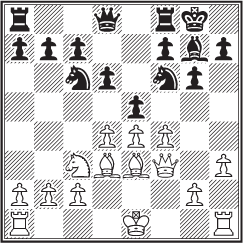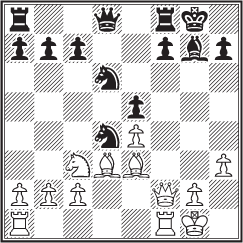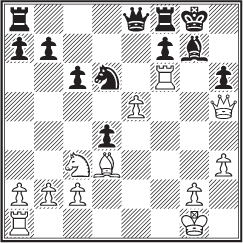
The following was the most dramatic game Fischer won from Benko in a series that hadn’t been as one-sided as might be supposed. Benko had crushed Fischer positionally in their first game, at Portorož, and won in 27 moves at Buenos Aires 1960. Their four previous U.S. Championship games resulted in one Benko loss and three draws. Fischer’s reputation for Benko-bashing was based on the four wins, three draws and one loss in their two Candidates tournaments. (And that included one Fischer victory that could easily have been a loss.) In Chess Life, Fischer explained that he passed up a promising queen sacrifice, 13 ♕xe5 ♘g4! 14 ♕xg7+!. Among the reasons was that he had already assured himself of the brilliancy prize when he won Game 44 seven rounds previous.
Fischer – Pal Benko
U.S. Championship, New York 1963-64
Pirc Defense (B09)
1 |
e4 |
g6 |
2 |
d4 |
♗g7 |
3 |
♘c3 |
d6 |
4 |
f4 |
♘f6 |
5 |
♘f3 |
0-0 |
6 |
♗d3 |
|
A rare move at the time, this soon replaced the more popular 6 ♗e2 c5 and 6 e5 dxe5.
6 |
... |
♗g4? |
This plausible strategy, to win control of d4, was recommended in opening books of the day, such as Rabar and Timet’s Sahovska Otvorenja, which gave 7 0-0 ♘c6 as promising.
Benko had experience with 6...♘bd7 7 0-0? (a book move in 1963) e5!, based on 8 dxe5 dxe5 9 fxe5 ♘xe5 10 ♘xe5 ♕d4+ and ...♕xe5. But he knew that 7 e5! hands White an obvious edge.
7 |
h3! |
♗xf3 |
8 |
♕xf3 |
♘c6 |
9 |
♗e3 |
e5 |
On 9...♘d7 White has 10 e5!, which is much stronger than the ECO-recommended 10 ♕f2.

10 |
dxe5! |
|
Black’s play is justified after 10 fxe5? dxe5 11 d5 ♘d4 12 ♕f2 c6!.
10 |
... |
dxe5 |
11 |
f5 |
gxf5 |
In Chess Life, Fischer said 11...♘d4 12 ♕f2 gxf5 made little difference. By the time My 60 Memorable Games appeared he was able to cite a 1964 game that went 13 exf5 b5 14 0-0 c5 15 ♘e4 c4 16 ♘xf6+ ♕xf6 17 ♗e4 followed by c2-c3 and ♖ae1 with a potent initiative.
Slightly better is 12...b5 and 13 0-0 c5. White has a slight edge after 14 ♘xb5 ♘xb5 15 ♗xb5 ♘xe4 16 ♕f3 ♘d2 17 ♗xd2 ♕xd2 18 ♗d3 e4.
12 |
♕xf5! |
|
Here 12 exf5? would allow a good line-clearing offer, 12...e4! (13 ♘xe4 ♘e5).
12 |
... |
♘d4 |
Later 12...♕d7 was recommended but 13 ♕xd7 ♘xd7 14 ♘d5 ♖fc8 15 ♗b5 is hardly pleasant for Black.
13 |
♕f2 |
|
Fischer said he was tempted by 13 ♕xe5. Then 13...♘g4 forces him into a dangerous-looking sacrifice, 14 ♕xg7+ ♔xg7 15 hxg4, e.g. 15...♘e6 16 e5 ♖h8 17 ♗h6+ ♔g8 18 ♘e4! or 15...♖e8 16 0-0-0 ♖e6 17 e5.
But after the game he appreciated that 15...♘c6 is a tough defense.
After 13 ♕f2 White enjoys a choice between queenside castling followed by g4-g5, and ♘e2-g3 or kingside castling followed by ♕g3 and doubling on the f-file.
13 |
... |
♘e8 |
Black is several moves away from having to deal with major threats yet his passive situation is semi-critical. Benko may have talked himself out of 13...c5 14 ♗g5 ♕d6 15 0-0-0 but he needs counterplay desperately.
14 |
0-0 |
♘d6 |
The knight can support ...f5 or ...c5-c4. For example, 15 ♘e2 f5 or 15 ♘d5? f5 16 ♗xd4 fxe4! and Black is back in the game.

15 |
♕g3! |
|
Fischer took a considerable time before choosing this over 15 g4. Both moves discourage 15...f5, e.g. 15 ♕g3 f5 16 ♗h6 ♕f6 17 ♗xg7 ♕xg7 18 ♕xg7+ ♔xg7 19 exf5 ♘6xf5 20 ♖ae1 with a great endgame. But the queen move allows White to take aim at Black’s most vulnerable point, h7.
15 |
... |
♔h8 |
16 |
♕g4! |
c6 |
Fischer felt Black’s next was the losing move but this one can share the guilt. The last chance for counterplay was 16...c5 even though 17 b3 ♖c8 18 ♘d5 keeps White on top (18...f5 19 exf5 ♘6xf5 20 ♗xd4! ♕xd5 21...♗b2, e.g. 21...♘e3 22 ♖xf8+ and ♕e4).
17 |
♕h5 |
♕e8? |
Black meets the threat of 18 ♗xd4 exd4 19 e5 with 19...f5 – but he misses an exquisite finesse. He had to play 17...♘e6 or 17...c5.
18 |
♗xd4 |
exd4 |
19 |
♖f6!! |
|
By freezing the f-pawn, White threatens mate in two (20 e5 and 21 ♕xh7).
19 |
... |
♔g8 |
20 |
e5 |
h6 |

Trap: Black keeps the game alive after 21 ♖xd6 ♕xe5!.
21 |
♘e2 |
Resigns |
The attacked knight cannot move (21...♘b5 22 ♕f5!) and 21...♗xf6 22 ♕xh6 is instant death.